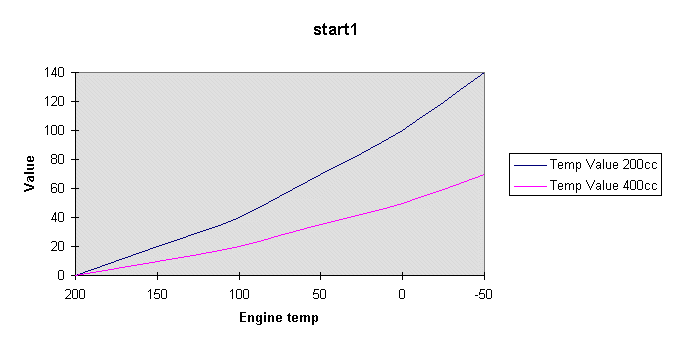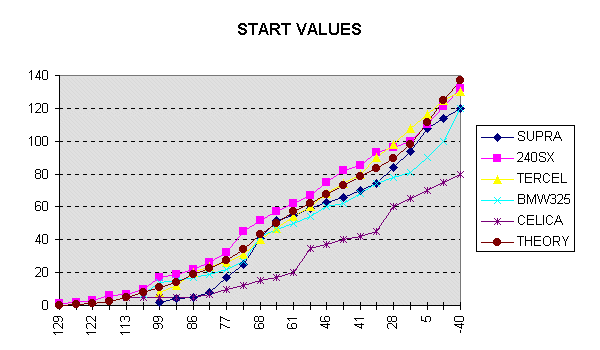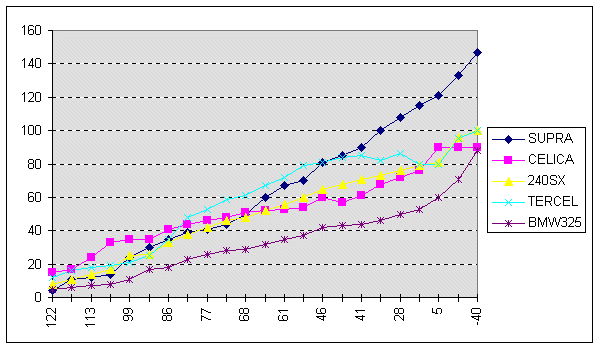


Background Information
Gasoline does not vapourize as easily at cold temperatures as it does at warmer temperatures. When the metal parts of an engine are cold and fuel hits them, the fuel tends to condense rather than vapourize. As fuel and air need to be in the proper proportions to combust properly, this fuel puddling problem leads to lean and rich regions in the mixture which are difficult to ignite. Generally, the mixture is extremely lean by the time it reaches the combustion chamber because much of the fuel has condensed and puddled in the intake manifold and ports, not reaching the chamber. Because of this phenomena, we have to increase the amount of fuel injected to ensure that enough fuel reaches the chambers to bring the mixture into its ignitable range.

The chart above shows two hypothetical curves for start or engine temp values. Notice that the values increase at colder temperatures. Please note the graphs below. Actual values may vary considerably from theoretical ones!
Programming Theory
On the SDS EM-3, you can program the number of start cycles from 0 to 255. The larger this number, the longer the start enrichment will last. The larger the start value, the more fuel is injected at that temperature. One engine may require fuel enrichment during cranking and startup to last for a long time while the next engine may need it to last less time. Only trial and error will tell. Once the start cycles are over, the ECU reverts to the engine temp values to supply a richer mixture as the engine warms up. These are also programmable. As the engine warms up, the ET values will decrease to 0 at about 140F on most applications as the fuel is vapourizing normally at this temperature and no extra fuel is required.
Programming Practice
If your engine starts well but stalls after a few seconds, generally the start values are OK but the ET values are too low. You only get one try per starting attempt to set the number of start cycles and start fuel values so this may take some time to set up. For ET values, you can often set these quite well in one sitting by using the following procedure:
Start the engine and call up Gauge 1 mode to monitor the ET. As the ET changes, move the mixture knob slowly richer until the engine begins to stumble, now lean it slowly until you get a stunble again. If the the knob can be turned about the same amount on either side of the 0% mark before encountering a stumble, the ET value at that temperature is close. If you just turn the knob a few percent lean and it stumbles, the value at that ET needs to be slightly higher. Scroll to the ET values and change the one at the current ET to compensate. Once you have accessed the ET values, you can flick back to Gauge 1 by pressing the gauge button once to wait for the system to latch the next ET. Repeat the knob procedure at each ET and flick back to ET values quickly by pressing gauge.
When everything is set correctly, the engine should start quickly and warm up and drive off without any stumbles. The fast idle option will allow easier warmup on MAP equipped systems and is highly recommended. On TP systems, starting may be aided by pumping the accelerator. This activates the accelerator pump function and the ECU will use the higher TP value as the throttle is opened rather than the lower closed throttle value. Starting a TP system therefore may involve a bit of a technique as well as manipulation of the start and ET values. With a MAP system, the ECU will use the relatively high MAP values at the cranking manifold pressure which is usually near atmospheric. This automatically richens the mixture considerably during cranking as the primary pulse width is generated by MAP multiplied by RPM values.
Update 12/19/02
SDS users have asked for more guidelines with regards to ET and START values. Below, we have compiled data from several Racetech shop cars which are driven all year in temperatures down to -35C. The chart below shows the different injector flow rate vs. cylinder displacement relationship. Subsequent charts show temperature vs. START value and temperature vs. engine temp or ET values. Temps are in Fahrenheit.

It should be noted that START values add a fixed amount to the basic pulse width and ET values add a PERCENTAGE to the basic pulse width. In addition, the maximum pulse width that can be generated by the ECU is 32 milliseconds. It's possible with high START and ET values entered at low temperatures, combined with high RPM FUEL values associated with small injectors in large cylinders that you can approach or exceed this limitation. The result may be difficult starting in very cold weather. For this reason, we don't recommend small injectors in large cylinders if the engine is to be operated in cold climates.

ENGINE TEMP VALUES

How fuel vaporizes, the injector spray pattern, cranking speed, cranking vacuum and the head/manifold design all have an effect on the fuel required to start and warm up properly. These factors vary widely between engines so the values required are unpredictable. We present these graphs as a rough guideline.
START CYCLES control the amount of time that start enrichment lasts. We have seen people cranking this value way up to compensate for poor starting, not understanding its function. In practice, the START CYCLES value for most engines ends up in the 10-30 range. In no case would this need to be greater than 40 in our experience. Theoretically, a 6 or 8 cylinder application would require a higher setting here than a 4 cylinder although the BMW325 here uses only a 10 with great success.